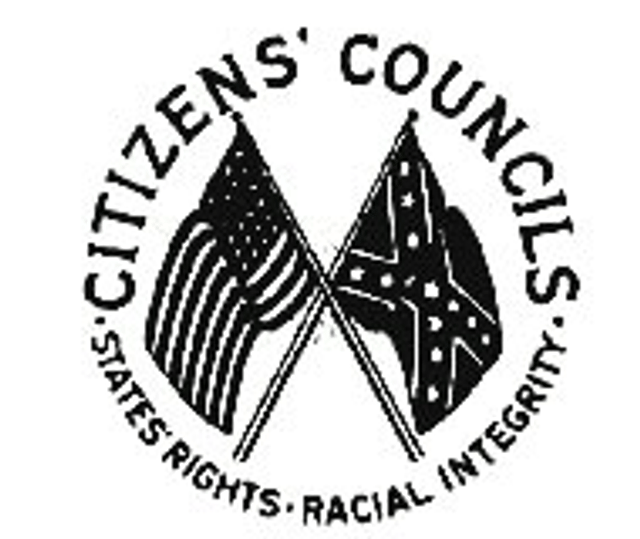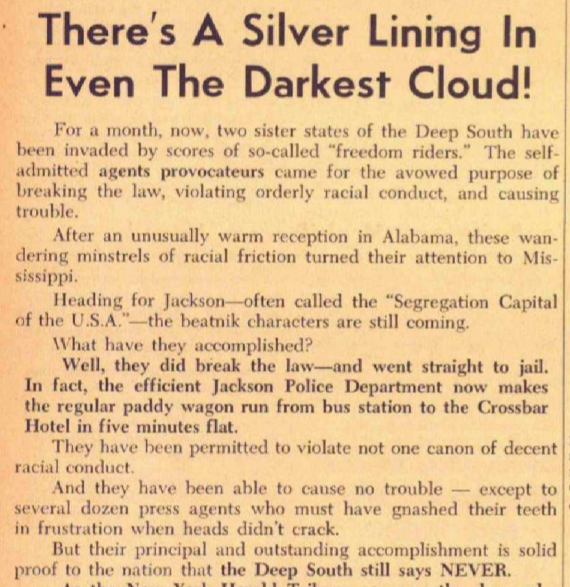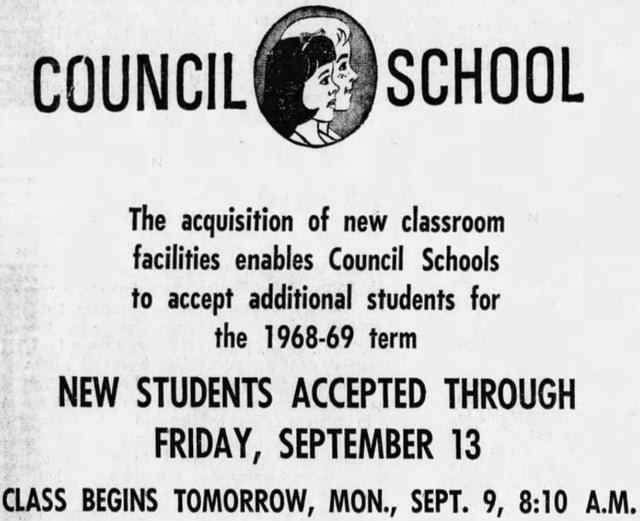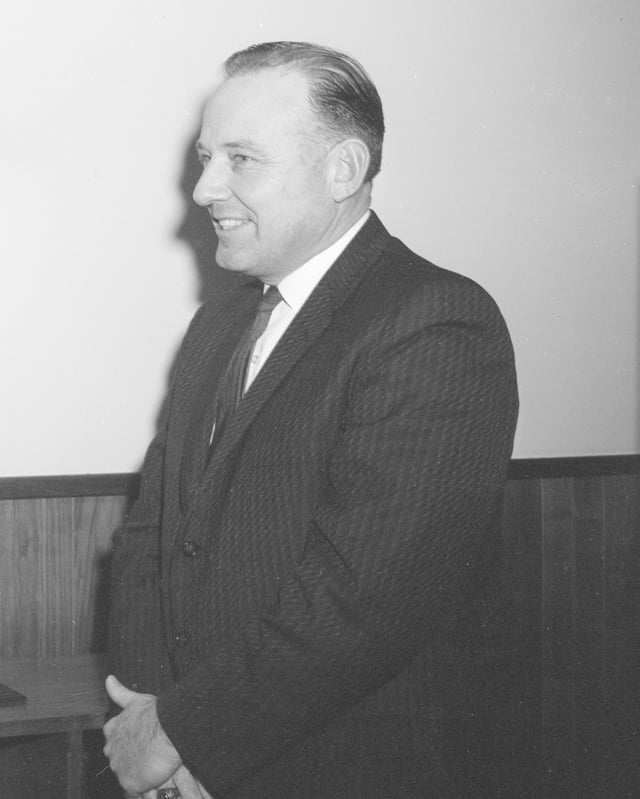Citizens' Councils

Citizens' Councils

| Abbreviation | WCC |
|---|---|
| Motto | States' Rights – Racial integrity |
| Successor | Council of Conservative Citizens |
| Formation | July 11, 1954 (1954-07-11) |
| Type | NGO |
| Purpose | Maintaining segregation and white supremacy in the South. |
Membership | 60,000 (1955) |
Founder | Robert B. Patterson |
The Citizens' Councils (its enemies usually called it White Citizens' Councils) were an associated network of white supremacist, extreme right[1] organizations in the United States, concentrated in the South. The first was formed on July 11, 1954.[2] After 1956, the name was Citizens' Councils of America. With about 60,000 members across the United States,[3] in the South, the groups were founded primarily to oppose racial integration of public schools following the US Supreme Court ruling in 1954 that segregated public schools were unconstitutional. They also opposed voter registration efforts in the South, where most blacks had been disenfranchised since the turn of the 20th century, and integration of public facilities during the 1950s and 1960s. Members used intimidation tactics including economic boycotts, firing people from jobs, propaganda, and threatening and committing violence against civil-rights activists.
By the 1970s, following passage of federal civil rights legislation and its enforcement by the federal government, the influence of the Councils had waned considerably. The council's mailing lists and some of their board members found their way to the St. Louis-based Council of Conservative Citizens, founded in 1985.[3][4][5]
| Abbreviation | WCC |
|---|---|
| Motto | States' Rights – Racial integrity |
| Successor | Council of Conservative Citizens |
| Formation | July 11, 1954 (1954-07-11) |
| Type | NGO |
| Purpose | Maintaining segregation and white supremacy in the South. |
Membership | 60,000 (1955) |
Founder | Robert B. Patterson |
Birth and development

Clipping from Citizens' Council newspaper, June 1961
In 1954, the US Supreme Court ruled in Brown vs. Board of Education that segregation of public schools was unconstitutional. Schools and other public facilities were segregated by state law in Southern states. Some sources claim that the first White Citizens' Council started after this in Greenwood, Mississippi.[6] Others say that the group originated in Indianola, Mississippi.[7] The recognized leader was Robert B. Patterson of Indianola,[2][8] a plantation manager and a former captain of the Mississippi State University football team. Additional chapters were established in many other southern towns.
At this time, most Southern states enforced racial segregation of all public facilities; in places where local laws did not require segregation, Jim Crow harassment enforced it. From 1890 to 1908, most Southern states passed new constitutions or laws that resulted in the disfranchisement of most blacks through barriers to voter registration and voting. Despite civil rights organizations winning some legal challenges, such as the prohibition of white primaries, most blacks in the 1950s were still disfranchised in the South. They risked retaliation by challenging segregation of seating on buses and at lunch counters, including in department stores.[9] The risks did not end immediately after passage of the Voting Rights Act of 1965.
Patterson and his followers formed the White Citizens Council in part to respond with economic retaliation and violence to increased civil rights activism. The Regional Council of Negro Leadership (RCNL), a grassroots civil rights organization founded in 1951 by T. R. M. Howard of the all-black town Mound Bayou, Mississippi, was based 40 miles from Indianola. Aaron Henry, a later official in the RCNL and the future head of the Mississippi NAACP[10] had met Patterson during their childhood.
Within a few months, the White Citizens Council had attracted similar racist members; new chapters developed beyond Mississippi in the rest of the Deep South. The Council often had the support of the leading white citizens of many communities, including business, law enforcement, civic and sometimes religious leaders, many of whom were members. Member businesses, such as newspaper publishing, legal representation, medical service, were known for collectively acting against registered voters whose names were first published in local papers before additional retaliatory actions were taken against them.[11]
Meetings, newsletter, and publishing
Unlike the secretive Ku Klux Klan but working in unison, the White Citizens Council met openly. It was seen superficially as "pursuing the agenda of the Klan with the demeanor of the Rotary Club".[12] The council published a newsletter, The Citizens' Council, from 1954 until 1973.
Council Schools in Jackson, MS

A 1968 advertisement for Jackson area schools operated by the Council
The White Citizens' Council in Mississippi prevented school integration until 1964.[14] As school desegregation increased in some parts of the South, in some communities the White Citizens' Council sponsored "council schools," private institutions set up for white children. Such private schools, also called segregation academies, were beyond the reach of the ruling on public schools.[15] Many of these private "segregation academies" continue to operate today.
The Council sponsored a system of twelve segregated schools in Jackson, Mississippi.[16]
Political influence

Joe D. Waggonner, Jr.
Many leading state and local politicians were members of the Councils; in some states, this gave the organization immense influence over state legislatures. In Mississippi, the State Sovereignty Commission was established, ostensibly to encourage investment in the state and promote its public image. Although funded by taxes paid by all state residents, it made grants to the segregationist Citizens' Councils, in some years providing as much as $50,000. This state agency also shared information with the Councils that it had collected through its secret police-type investigations and surveillance of integration activists.[17] For example, Dr. M. Ney Williams was both a director of the Citizens' Council and an adviser to governor Ross Barnett of Mississippi.[18]
Barnett was a member of the Council, as was Jackson mayor Allen C. Thompson.[19] In 1955, in the midst of the bus boycott seeking integration of seating on city buses, all three members of the Montgomery city commission in Alabama announced on television that they had joined the Citizens' Council.[20]
Numan Bartley wrote, "In Louisiana the Citizens' Council organization began as (and to a large extent remained) a projection of the Joint Legislative Committee to Maintain Segregation."[21] In Louisiana, leaders of the original Citizens' Council included State Senator and gubernatorial candidate William M. Rainach, U.S. Representative Joe D. Waggonner, Jr., the publisher Ned Touchstone, and Judge Leander Perez, considered the political boss of Plaquemines and St. Bernard parishes near New Orleans.[22] After he left the editorship of the Shreveport Journal in 1971, George W. Shannon relocated to Jackson, Mississippi, to work on The Citizen, a monthly magazine of the Citizens' Council. The Citizen continued publication until January 1979, by which time Shannon had returned to Shreveport.[23]
On July 16, 1956, "under pressure from the White Citizens Councils,"[24] the Louisiana State Legislature passed a law mandating racial segregation in nearly every aspect of public life; much of the segregation already existed under Jim Crow custom. The bill was signed into law by governor Earl Long on July 16, 1956 and went into effect on October 15, 1956.
The act read, in part:
An Act to prohibit all interracial dancing, social functions, entertainments, athletic training, games, sports, or contests and other such activities; to provide for separate seating and other facilities for white and negroes [lower case in original] ... That all persons, firms, and corporations are prohibited from sponsoring, arranging, participating in or permitting on premises under their control ... such activities involving personal and social contact in which the participants are members of the white and negro races ... That white persons are prohibited from sitting in or using any part of seating arrangements and sanitary or other facilities set apart for members of the negro race. That negro persons are prohibited from sitting in or using any part of seating arrangements and sanitary or other facilities set apart for white persons.[24]
Major media outlets observed the support George Wallace received from groups such as White Citizens' Councils. It has been noted that members of such groups had permeated the Wallace campaign by 1968 and, while Wallace did not openly seek their support, nor did he refuse it.[25]
Voter suppression
Citizens' Councils conducted voter purges to remove Black voters from election rolls.[26]
Before the practice was found illegal in a federal court case of 1963, the Council pushed a public challenge law allowing two voters to challenge another voter to see if he was lawfully registered, a provision they used to purge the rolls of Black voters. In one parish, Bienville Parish, 95% of Black voters were purged.[26] Similarly, the Council distributed such pamphlets as "Voter Qualification Laws in Louisiana: The Key to Victory in the Segregation Struggle" to white registrars and required them to participate in mandatory seminars about preventing Black registration and purging Black voters.[27]
Economic retaliation and violence
Although the White Citizens Council publicly eschewed the use of violence,[2] they supported harsh economic and political tactics used against registered voters and activists. The White Citizens Council members collaborated to threaten jobs, causing people to be fired or evicted from rental homes; they boycotted businesses, ensured that activists could not get loans, among other tactics.[6][11] As historian Charles Payne notes, "Despite the official disclaimers, violence often followed in the wake of Council intimidation campaigns."[12] Occasionally some Councils directly incited violence, such as lynchings, shootings, rapes and arson, as did Leander Perez during the New Orleans school desegregation crisis. In some cases, Council members were directly involved in acts of violence. Entertainer Nat King Cole was assaulted in Birmingham, Alabama while on tour. Byron De La Beckwith, a KKK and Council member, murdered Medgar Evers, the head of the NAACP in Mississippi.
For instance, in Montgomery, Alabama, during the 1961 Montgomery Bus Boycott, at which Senator James Eastland "ranted against the NAACP"[28] at a large openly held Council meeting in the Garrett Coliseum, a mimeographed flyer publicly espousing extreme racial White Citizens Council and Ku Klux Klan rhetoric was distributed, parodying the Declaration of Independence and saying:
When in the course of human events, it becomes necessary to abolish the Negro race, proper methods should be used. Among these are guns, bows and arrows, sling shots and knives.We hold these truths to be self-evident that all whites are created equal with certain rights; among these are life, liberty and the pursuit of dead niggers.[28][29]
The Citizens' Councils used economic tactics against African Americans whom they considered as supportive of desegregation and voting rights, or for belonging to the NAACP, or suspected of being activists. The tactics included "calling in" the mortgages of black citizens, denying loans and business credit, pressing employers to fire certain people, and boycotting black-owned businesses.[30] In some cities, the Councils published lists of names of NAACP supporters and signers of anti-segregation petitions in local newspapers in order to encourage economic retaliation.[31] For instance, in Yazoo City, Mississippi in 1955, the Citizens' Council published in the local paper the names of 53 signers of a petition for school integration. Soon afterward, the petitioners lost their jobs and had their credit cut off.[32] As Charles Payne puts it, the Councils operated by "unleashing a wave of economic reprisals against anyone, Black or white, seen as a threat to the status quo".[12] Their targets included black professionals such as teachers, as well as farmers, high school and college students, shop owners, and housewives.[11]
Medgar Evers' first work for the NAACP on a national level involved interviewing Mississippians who had been intimidated by the White Citizens' Councils and preparing affidavits for use as evidence against the Councils if necessary.[33] Evers was assassinated in 1963 by Byron De La Beckwith, a member of the White Citizens' Council and the Ku Klux Klan.[34] The Citizens' Council paid Beckwith's legal expenses in his two trials in 1964, which both resulted in hung juries.[35] In 1994, Beckwith was tried by the state of Mississippi based on new evidence, in part revealed by a lengthy investigation by the Jackson Clarion Ledger; he was convicted of first-degree murder and sentenced to life in prison.[36]
Demise of the councils and reconstitution
By the 1970s, as white Southerners' attitudes toward desegregation began to change following passage of federal civil rights legislation and enforcement of integration and voting rights in the 1960s, the activities of the White Citizens' Councils began to wane. The Council of Conservative Citizens, founded in 1985 by former White Citizens' Council members,[3] continued the agendas of the earlier Councils.
See also
Civil Rights Movement
Timeline of the civil rights movement
Defenders of State Sovereignty and Individual Liberties